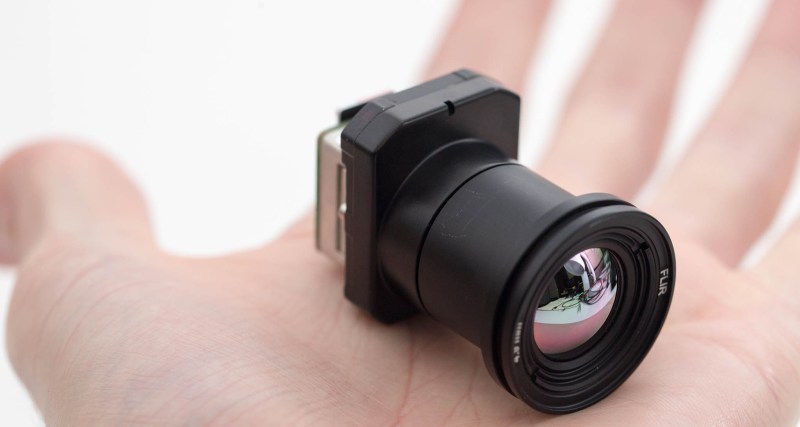FLIR are making some really great miniature thermal cameras these days, designed for applications such as self-driving cars, and tools that help keep firefighters safe. That’s great and all, but these thermal cameras are so cool, you really just want to play with one. That’s what [greg] was thinking when he designed a PCB backpack that captures thermal images from a FLIR Boson and stores it on an SD card. It’s a thermal action cam, and an impressive bit of FPGA development, too.
The FLIR product in question is a Boson 640, an impressive little camera that records in 640×512 resolution, with a 60 Hz update rate. This one’s got the 95° field of view, giving it a very good specification in a very small footprint. This is a huge improvement over FLIR’s Tau camera, for which [greg] built a breakout board with Ethernet and DDR memory a few years ago. Once he found out about the Boson, he figured a backpack PCB for this camera would be possible and a great excuse to teach himself FPGAs with a hands-on project.
With an impressive ability to find the perfect part, [greg] sourced a Lattice iCE40 FPGA in an 8×8 mm package along with an 8 Mbit HyperRAM in a 6×8 package. This combination allows for all the chips to fit behind the Boson camera. Add in an microSD card slot and a few connectors and this breakout board is very close to being a commercial product, for whatever forward looking infrared needs you might have.
















None of these FLIR projects mention the germanium lenses or their cost / performance impact on the projects. :/
(I may regret asking this, but…) Elaborate, please?
Its expensive.
Germanium is a rare earth mineral, and the lens is close to 80 if not 90% of the price of the project. Expect even a small lense to cost a few iPhone Xs Max…
No, it’s not.
It is not extremely rare, it is in the same ball park as tin on the earths crust. Maybe the difficulty is in refining and purifying it.
https://en.wikipedia.org/wiki/Abundance_of_elements_in_Earth%27s_crust
You can source 10 pcs 10mm germanium windows (for protection) discs for 20-30usd pc. Not realy dirt cheap but also not iphone xs range
No. The term “rare earths” is reserved for the Lanthanides (plus Scandium and Yttrium): that makes 15 elements[1]. (“Rare earth minerals are minerals containing those). Rare earths have become significant especially because of Samarium and Neodymium (and possibly historically Yttrium), indispensable in the strong permanent magnets used in modern generators and motors (yes, your drone, your e-bike or your e-car).
Germanium lives at quite another place in the periodic table [2], right there with carbon and silicium. Go have a quiet and pleasant walk around the periodic table. It’s worth it, believe me!
[1] https://en.wikipedia.org/wiki/Rare_earths
[2] https://en.wikipedia.org/wiki/Periodic_table
Germanium and Gallium Arsenide lenses (depending on the wavelength range of interest) of this diameter are available in various focal lengths at a ~$40 US per piece (or less) price point these days.
I guess if you’re willing to fork out $3k+ for the camera, the lens price is negligible.
Correct. The lens is a small fraction of the total price.
$3520 for the camera, in case you were wondering as I was
Cor Blimey. Are they having a laugh?
Find better for cheaper!
I have a couple FLIR and a couple Seek modules right now, and there’s just no comparison. Pixel count is nice, but low noise is what makes the FLIR image quality so useful.
I’d love just a plain old USB webcam thermal camera. Even a shitty little Lepton module would be fine, as long as it enumerates as standard UVC for easy driverless use in any setting.
Some software might not comprehend an 80×60 image, so it would be helpful if the USB side of things could upscale that and offer it as a more-normal-sounding resolution. But beggars can’t be choosers, and whoever gets around to implementing it will surely have better thoughts than I on the matter.
The Boson camera cores do provide a UVC interface over USB 2.
You want a FLIR Lepton core on a PureThermal1 board.
Much cheaper than the Boson.
USB UVC ready to go.
https://www.pureengineering.com/projects/purethermal1
The world gets a lot less safe when that becomes an easily accessible peripheral. Be careful what you wish for.
the phone dongles work (eg Seek) if you get an adaptor